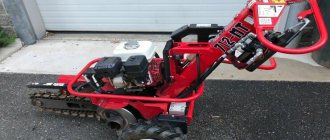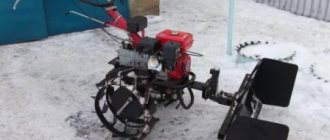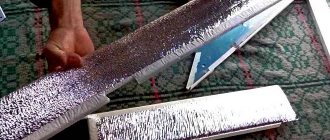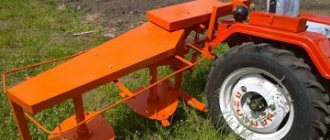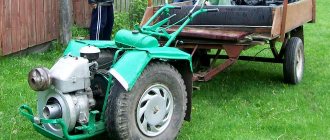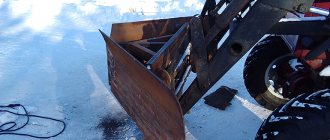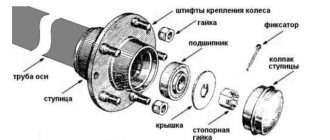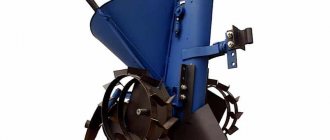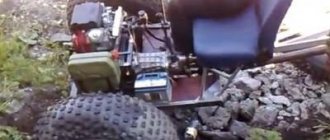How to make hydraulics on a walk-behind tractor with your own hands: installing NSh-10 and NSh-16
Hydraulics on a walk-behind tractor will increase the productivity of the mechanism, increase the reliability of the design and improve control of the unit. Making hydraulics for a walk-behind tractor with your own hands is not at all difficult; even a person who does not have special skills can handle it.
Let's consider the advantages of a walk-behind tractor with a hydraulic drive:
- simplified management;
- the ability to connect hydraulically driven attachments: seeders, mowers, harvesting devices;
- improvement of the braking system.
How to install NSh-10 and NSh-16 on a walk-behind tractor with your own hands
In order to equip a walk-behind tractor with a hydraulic system, you must purchase a hydraulic kit from a specialized store, consisting of the following parts:
- gear pump NSh-10 (for walk-behind tractors with power up to 10 hp) or NSh-16;
- drive for the selected hydraulic pump with pulley;
- flanges;
- hydraulic oil tank;
- Oil filter;
- hydraulic distributor (one-, two- or three-section);
- kit for installing a hydraulic distributor, if you need levers for each group of pistons (for motor cultivators, the best option would be 3 levers: for starting, braking and control);
- hydraulic steering cylinder;
- hydraulic motor with a displacement of 25 or 50 cm3;
- RVD length 150 and 200 cm;
- fittings.
All hydraulic drive elements must be connected in series. First, the pump is connected to the walk-behind tractor engine. A hydraulic distribution unit is connected to it using tubes, to which, in turn, the hydraulic motor pistons fit, and a tank connected to the NS. When installing a hydraulic tank, be sure to install an oil filter.
After installing the system, it is necessary to check all connections for leaks to prevent possible leaks. And after a test ride, the walk-behind tractor steering wheel is adjusted.
Beginning of work
In order to create any device, they first think through or borrow its diagram. Depending on this, parts are purchased. Some craftsmen create homemade hydraulic distributors for mini tractors, which significantly saves money.
But not everyone will be able to assemble a high-quality and functioning structure. In some cases, it is better to purchase an element in a store or borrow it from other agricultural equipment.
The sequence of work will be as follows:
- creating a hydraulic diagram;
- purchasing the necessary parts;
- installation and connection of hydraulics;
- calibration of parts;
- checking the functioning of hydraulics with the transmission.
Hydraulics for a mini tractor from a walk-behind tractor necessarily includes the following components:
- hydraulic tank with oil;
- engine;
- hydraulic pump;
- hydraulic distributor;
- hydraulic motors and pistons;
- connecting hoses.
As an addition, filters for minitractor hydraulics, pressure meters and other auxiliary elements are installed.
This is done to protect the pump and motor from contamination by debris. When drawing up a diagram, consider the following data:
- The hydraulic pump must be located under the tank so that oil flows to it freely (under the influence of gravity). This is required so that there are no problems during startup.
- In order for the mechanism to work without interruption and last a long time, it is necessary to calculate the required power of all devices in the machine. Based on these data, a hydraulic pump is purchased. If its power is not enough, then an additional auxiliary pump is installed, which will be switched on separately at high load.
- In order for the mechanism to function for a long time, pressure measurement sensors and filters for oil purification are installed in it.
For the oil in the system to perform its function, it must be constantly in motion.
This is carried out by a hydraulic pump, which only performs the function of moving the volume of liquid through the system. The engine transmits torque to the pump and thereby forces it to pump liquid. It connects to the distributor. Depending on the position of the lever, the oil is returned through some tubes back to the tank or through others it is sent to the hydraulic motor or pistons. Hydraulics are installed on a mini tractor from a walk-behind tractor quite simply and, thanks to the high density of the oil, are capable of performing heavy traction operations.
How to make hydraulics for a walk-behind tractor
Homemade hydraulics for a walk-behind tractor will help you perform braking by reducing oil flow. When the load distribution handles are set to the off position, the wheels can be completely locked.
To make hydraulics for a motor cultivator, you will need an oil pump with a high flow rate of the working fluid and medium pressure. This pump will act on the hydraulic motors.
They are installed on a steel walk-behind tractor frame, which must be made from a rectangular pipe. Hydraulic motors should be installed as close to the drive axle as possible so that they rotate the rear wheels.
To determine in which direction the rotation will occur, you will need a distributor. To do this, you can use used parts and components of the Belarus tractor.
Oil flow occurs through the spool. A special swing bushing for the front axle is mounted in the middle of the device. This design will avoid the need for a cardan shaft.
Thus, the front wheels will change the operating system. When turning the cultivator, the track width changes, and the front axle is responsible for this in the system. For this reason, it is made independently.
As axle shafts with turning pins, rotary stands are mounted in the cultivator on the right and left. Then you need to synchronize the installation of wheel rims and disks. Their relative position should be offset.
After installation and connection, it is necessary to check the operation of the entire structure. If any parts are not functioning well, then you need to check all connections for leaks. Then, after eliminating all the defects, they turn on again and check the functionality of the walk-behind tractor with the hydraulic control system. You should also adjust the operation of the steering and movement hydraulics.
Self-made hydraulics for a motor cultivator will reduce the effort required to cultivate a plot of land and optimize all agricultural processes.
External tuning of the unit
Structurally, they are light, medium and practically no different. They consist of a power plant, chassis and controls. The operator resembles an ancient plowman, holding the handles of the machine with both hands. However, it is not protected from sunlight, rain, snow and heat coming from the engine. To create additional comfort, you do not need to spend additional money. Everything you need is at hand. External modernization of a walk-behind tractor involves the installation of a removable or permanent awning, an additional protective casing or hood over the power plant.
To work you will need:
- roulette;
- building level;
- Bulgarian;
- welding machine;
- electric drill;
- set of wrenches;
- steel or aluminum corner 30 x 30 mm;
- paint brush;
- acrylic paint;
- tarpaulin or cellular polycarbonate;
- flexible plastic.
Important Features and advantages of PIT chain saws (PIT)
External modification of the walk-behind tractor is carried out in the following sequence:
- Drawing up drawings. It is necessary to accurately calculate all dimensions of the frame and provide options for attaching it to the frame and handles.
- Carrying out markings, cutting out blanks for the awning, casing, wings and hood.
- Welding a frame from a corner. Drilling mounting holes, cleaning metal from rust, oil and dirt. Painting of the manufactured structure.
- Fitting the frame onto the frame. Marking and making holes in it. Fastening the frame with bolts and nuts, checking the reliability of all connections.
- Installation of plastic casings and awnings on frames.
There is an option to mount the instrument panel on the handle. This way the unit will look solid and representative. The operator additionally gets the opportunity to control the state of the power plant, know the speed of the machine and the distance traveled
When remodeling the walk-behind tractor from the outside, you need to pay attention to ensuring that air freely penetrates to the motor, cooling it efficiently.
How to make hydraulics on a Neva walk-behind tractor
When converting a heavy Neva MB-23 walk-behind tractor into a mini-tractor, equipping it with a hydraulic system will significantly increase productivity and facilitate control.
In the video below, the master shows the option of making hydraulics with his own hands.
What materials and equipment will be required for this:
- hydraulic distributor P80-3/1-22 or P80-3/1-222 (the unit can be purchased at the disassembly of the MTZ tractor), to the levers of which the shift knob is attached via transition rods;
- hydraulic pump NSh-10, which can also be removed from an old tractor;
- an oil tank with a filler neck, welded from a sheet of steel according to individual dimensions, the volume of which should be about 3 liters;
- oil filter (a part from a VAZ 2106 Zhiguli car is suitable);
- a drive for connecting NSh-10, made from individual parts independently (bearings, splined shaft, single or double belt pulley, belt, flange, fasteners and a steel platform 3-5 mm thick for installing the unit on the walk-behind tractor body);
- 2 T-40 hydraulic cylinders for connecting the front and rear linkages (they can also be found at a tractor disassembly site, or purchased new ones at an agricultural equipment store);
- hoses for connecting the system.
The connection is carried out in the same way as above.
Are hydraulics installed on your agricultural machinery?
Minitractor hydraulic attachment
Self-propelled hydraulics are a good way to expand the functionality of a mini tractor and save money. The assembly and installation of such a structure can be called even foldable. If the necessary parts and tools are available, any farmer can build this mechanism.
The main element of any hydraulic system is the pump, which circulates the fluid through the hoses. The oil reaches the pump from the reservoir. The pumping mechanism itself generates energy generated by the diesel engine of a mini tractor. Under the action of the pump, oil flows through flexible tubes to the distributor. To prepare hydraulics for a rural machine, you can use an NSh-10 pump.
It’s difficult to build a hydraulic distributor with your own hands, so the best solution would be to dismantle the already finished assembly from an old tractor. Suitable for installation on a self-propelled machine is the P-80 brand distributor, which is found on the MTZ tractor.
Through the distributor, the oil flows into the cylinder, the main functions of which lie in the lift and lowered hanging parts. The finished self-propelled hydraulics are installed on the frame of the self-propelled machine, closest to the drive axle.
The system can also be supplemented with motors, which must be connected to the wheels. In this way, hydraulics will not only raise the balance, but also take part in the galvanization of the minitractor.
When operating such hydraulics, oil will flow into the cylinders. For the rakhunok fall of this level, the wheels of the minitractor are pressed into place. When the wheel is moved to the neutral position, the drive wheels will be completely blocked
How to make hydraulics for a walk-behind tractor
Homemade hydraulics for a walk-behind tractor will help you do braking by reducing the flow of oil. When the load distribution handles are set to the non-working position, the wheels can be completely locked.
To make hydraulics for a motor cultivator, an oil pump with a high level of working fluid flow and medium pressure is useful. This pump will affect the hydraulic motors.
They are installed on the iron frame of the walk-behind tractor, which must be made from a rectangular pipe. Hydraulic motors should be installed as close as possible to the drive axle so that they rotate the rear wheels.
To find in which direction the rotation will occur, a distributor is useful. To do this, you can use used parts and components of the Belarus tractor.
Oil flow occurs through the spool valve. A special swing bushing for the front axle is mounted in the middle of the device. This design will avoid the need to introduce a cardan shaft.
Thus, the front wheels will change the operating system. When the cultivator turns, the track width changes, and the front axle is responsible for this in the system. For this reason, it is made independently.
As axle shafts with turning pins, rotary stands are mounted in the cultivator on the right and left. Then it is necessary to synchronize the installation of wheel rims and disks. Their mutual placement should be offset.
After installation and connection, you need to check the operation of the entire structure. If any parts do not work well, then it is necessary to check all connections for tightness. Then, after eliminating all the shortcomings, they turn it on again and inspect the functionality of the walk-behind tractor with a hydraulic control system. You should also adjust the operation of the steering and movement hydraulics.
Do-it-yourself hydraulics for a motor cultivator will reduce the effort required to cultivate a plot of land and improve all agricultural processes.
How to install NSh-10 and NSh-16 on a walk-behind tractor with your own hands
- gear pump NSh-10 (for walk-behind tractors with power up to 10 hp) or NSh-16;
- drive for selected hydraulic pump with pulley;
- flanges;
- hydraulic oil tank;
- Oil filter;
- hydraulic distributor (one-, two- or three-section);
- a kit for installing a hydraulic distributor, if levers are needed for each group of pistons (for motor cultivators, the best option would be 3 levers: for starting, braking and control);
- control hydraulic cylinder;
- hydraulic motor with a displacement of 25 or 50 cm3;
- RVD length 150 and 200 cm;
- fittings.
All parts of the hydraulic drive must be connected one by one. First, the pump is connected to the engine of the walk-behind tractor. A hydraulic distribution unit is connected to it using tubes, to which, in turn, the hydraulic motor pistons are connected, and a tank connected to the NS. When installing a hydraulic tank, it is imperative to install an oil filter.
hydraulics
I want to buy Neva 10 k.s. walk-behind tractor There's a belt drive there. I want to put hydraulics there near the front of the pump to create a rear and front linkage. I just don't know how. So that everything would be released and raised. What type of pump and cylinders are required so that the motor of the walk-behind tractor is not damaged. It will be possible to put it there so that the pump is turned on when I need it. Yes, and we can put our pump through the belt.
READ How to Reduce Motoblock Speed Using Pulleys
please help me please write to me in a personal message or give me a photo to earn money
earring; Read here » Tank, Pump NSh 6 or 10, coupling for drive type NSh GUR MAZ, distributor, filter, high pressure hose, cylinders.
It’s not obvious, but we really need spare parts. How many liters is the tank? the clutch - does it stick and vibrate the pump drive? Where do you put the filter and what kind is needed? What kind of power supply is needed to make everything turn on? front and back, and I want to build a lifting body, 600 kg heavy. Yes, forgetting to power and deafening tractor will not be necessary for the nsh-10
Even a low-power engine on a tractor has an engine of 12-15 hp and then under load it is not silent
the earring wrote: It’s out of our minds, but we really need spare parts. How many liters is the tank? the clutch - does it stick and vibrate the pump drive? Where do you put the filter and what kind is needed? What kind of power supply is needed to make everything turn on? front and back, and I want to build a lifting body, 600 kg heavy. Yes, forgetting to power and deafening tractor will not be necessary for the nsh-10
Clutch for the type of price “I just don’t know whether it will go to nsh10 or nsh6, Hydraulic filter, the theory is here.” I don’t know how to handle the tractor P80 tractor just yet, how it will behave on a small scale. If you don’t have anything, then buy it, everything is new and expensive.
EXCUSE YOU, AND YOU HAVE A VIEW OF WHAT THE VARTO MOVEMENT IS, SO I KNOW IT DEFINITELY through what, when the hanging rises, or let go. І WHAT IS YOUR NSH WARTO, I’ll explain LASKA HOW TO GET SUPPORT DO NOT LONG THE ENGINE, I WANT YOU TO ONLY LEAVE AND PUSH THE FUCKING RANGE OF THE SPORUDS KNIFE. hanging PLOW, ALE In general up to 150kg
GOOD DAY SO PENNY NOT Why do you want to earn money, for EVERYTHING TO PAY OR LET GO. IN FRONT BOTTOM AND BACK up to 150 kg OWNED, AND TO Earn money SHOULD VIN NOT DLMG, BUT JAKSHTO I will put on PRIVID NSH AXIS QIU couplings » SAY I CAN turn it off ABO VMIKATI PUMP, WHEN REQUIRED BY ME, SCHOB VIN PERMANENTLY NOT CHALKING
earring having written: I CAN SAY VIMICATHI VMIKATI PUMP, WHEN YOU NEED ME, SCHOB VIN PERMANENTLY NOT CHALLENGING
At a minimum, you can try to turn on CAPS LOCK, the last key in the 3rd row from the bottom, evil, and normally get along with the people. Your food: The NSH shaft is obligatory to blame for the fact that this type of coupling needs to be installed all the same. If you install an axle like this (T40 tractor) between this drive, you can turn on spacers or the like.
I took the T40 for the butt only because on the same part a pressure reducing valve is installed that regulates the flow of oil, so that part of it is directed to the hydraulic system of the mounted one, part of it to the power steering or to the fuel (here one of the main ones is installed). Tse in food “should not DLMG”. In addition, some of the distributors and similar valves operate on the same principle (they also regulate the fluidity of the suspension) and therefore will also be important to the engine. Hospital workers are constantly in the dark, from normal to the simplest type of mixing in the bathtub. You can bet that you will not, but as a minimum, a two-spool valve will be required for your flow of drinks to be dependent on at least three hydrocylinders. Whatever the buck, you’ll know what it is. The liquid must be stored under the hydraulic cylinders. If you hang (hinge) the GC rod as much as possible and immediately lift the rack platform in the tank, you may lose the chance to add oil so that the GC “does not come out in the wind.” The filter can be any kind, but if it is completely clean, you can use the simplest mesh or detergent, or even without it. Good luck in everyday life, in my special thought, you still can’t cook the egg you’ve seen. Approximately as if I installed a bi-hydraulic drive for pressing buttons on the screen on my Smart Samsung i9000 for 200 dollars for 400 bucks and 20 kg in a backpack on the back of the system itself.
How to make hydraulics on a walk-behind tractor with your own hands: installing NSh-10 and NSh-16
Hydraulics on a walk-behind tractor will increase the performance of the mechanism, increase the reliability of the design and improve the control of the unit. to make hydraulics for a walk-behind tractor with your own hands; even a person who does not have special abilities can handle it.
Let's look at the advantages of a walk-behind tractor with a hydraulic drive:
- simplified management;
- the ability to connect suspended hydraulically driven equipment: seeders, mowers, harvesting devices;
- improvement of the braking system.
Advantages of the device
First, let's consider what benefits the created creation will bring. Creating a mini tractor with your own hands is not so difficult, because all the parts can be purchased separately, and tanks, distributors, pumps, engines and other components of the machine can be freely borrowed from other devices.
For farmers, homemade tractors are not uncommon; this simple unit can be used to perform many useful tasks: plowing the land, mowing and collecting grass, dragging large loads and many others. With such a big benefit from the device, you can still save money on its purchase.
How to make hydraulics on a Neva walk-behind tractor
When converting a languid Neva MB-23 walk-behind tractor into a mini-tractor, equipping it with a hydraulic system will significantly increase productivity and facilitate control.
In the video below, the master shows the option of making hydraulics with his own hands.
What materials and equipment will be needed for this:
The connection is carried out similarly to the above method.
Are hydraulics installed on your agricultural machinery?
How to make hydraulics for a walk-behind tractor with your own hands
This article is intended to dispel three myths made about homemade hydraulics on a walk-behind tractor :
- This homemade product to make .
- Only an experienced master will cope with this technical task.
- You don’t have enough special skills to make hydraulics for a walk-behind tractor with your own hands.
The hydraulic system for a walk-behind tractor, at first glance, will seem like a very complex mechanism that to make with your own hands and will pose a lot of difficulties when creating it. We invite you to go through the most basic questions about creating your own hydraulics for a walk-behind tractor. Go ahead to get acquainted to debunk the myths about the hydraulic walk-behind system forever!
How to make hydraulics for a walk-behind tractor yourself
The recommendation from specialists and masters of their craft is to use homemade hydraulics with a drive. This will give:
- The ability to operate the unit is simple;
- Connect a variety of active and passive hydraulically driven attachments, which means ensuring work with seeders, mowers, potato diggers, potato planters, plows and rototillers.
- Improved braking system.
Honor should: the walk-behind tractor will slow down by reducing the amount of lubricant (oil) in the engine. And in order to block the wheels, you need to put the load distribution handles in the non-working position.
For homemade hydraulics you will need two main parts:
- Medium pressure oil pump;
- Hydraulic motors (hydraulic motors);
The pump must influence the hydraulic motors. They need to be installed on the iron frame of the walk-behind tractor. It is made from a rectangular profile. Important. install closer to the drive axle to rotate the rear wheels. To determine the direction of rotation, you must use a distributor.
You can also use former spare parts from a tractor that you have at your disposal. Oil is poured through the spool.
A bushing needs to be mounted in the middle of the unit specifically to swing the front axle. A structure of this kind can help eliminate the need for a cardan shaft. Thanks to this parameter, the front wheels can change the work structure. For example, during a turn, the track width changes. This action is influenced by the front axle; therefore, it is also often made by hand, just like the hydraulics for a walk-behind tractor.
Axle shafts with steering pins on the left and right sides can be replaced instead of axle shafts. To do this, you need to install rotary stands. The next step is to synchronize the installation of offset rims. Then, after installation, it is imperative to check the operation of all devices. Perhaps some parts are not functioning as they should, in this case. All connections must be checked for leaks.
After all the shortcomings have been eliminated, you need to turn on and check the functionality of the walk-behind tractor with homemade hydraulics.
Important: adjust the steering and movement hydraulics on the walk-behind tractor.
In order to make it easier to navigate the creation of your own hydraulic system, a diagram has been prepared for the walk-behind tractor (see below). Designation of this drawing:
- Number 1 – Distributor;
- Number 2 – Check valve;
- Red Line – High Pressure Hoses;
- Blue line – Hoses without pressure;
Making hydraulics for a walk-behind tractor with your own hands is easier than it seems. This will expand your capabilities in optimizing all agricultural processes.
Hydraulics
help kind people
I want to buy a Neva 10 hp walk-behind tractor, it has a belt drive. I want to put hydraulics in there in the form of a nsh pump. To make a rear and front linkage. I just don’t know how. So that everything is released and raised. what brand of pump and cylinders is needed so that the motor of the walk-behind tractor does not stall. If the pump runs constantly, there will be a load on my engine. if there is anything I can put there so that the pump turns off when I need it. And is it possible to install our pump through a belt.
please help me, write to me in a personal message or give me a photo of how to make it
earring; Read here » > Tank, Pump NSh 6 or 10, coupling similar to NSh power steering MAZ drive, distributor, filter, high pressure hose, cylinders.
I don’t understand something, but what kind of spare parts are needed? i.e. the tank is how many liters? The clutch is what turns the pump drive on and off? Where should I put the filter and what kind is needed? What kind of distributor is needed to turn everything on? front and rear, and I want to make a lifting body, a trolley for 600 kg. Yes, I forgot to ask, but the walk-behind tractor will not stall due to the load of NSh-10
The engine is very weak. I have a 12-15 hp engine on my tractor, and sometimes it stalls under load.
Seryoga wrote: I didn’t understand something, but what kind of spare parts are needed. i.e. the tank is how many liters? The clutch is what turns the pump drive on and off? Where should I put the filter and what kind is needed? What kind of distributor is needed to turn everything on? front and rear, and I want to make a lifting body, a trolley for 600 kg. Yes, I forgot to ask, but the walk-behind tractor will not stall due to the load of NSh-10
A coupling like this » > but I don’t know whether it will fit NSh10 or NSh6. The filter is hydraulic, the theory is here » > . Tractor distributor P80, but I don’t know how it will behave in a small flow. If you have nothing, then buying everything new is expensive.
SORRY, WHAT IS YOUR ENGINE STOPPING FROM, AND HOW TO UNDERSTAND IT STALLS BECAUSE OF WHAT, WHEN YOU LIFT THE LIFT OR RELEASE. AND WHAT IS YOUR NSH, PLEASE EXPLAIN HOW TO DO SO THAT THE ENGINE DOESN’T STALL, I WANT IT TO ONLY BE RELEASED OR RISED IN THE FRONT OF THE KNIFE AND IN THE BACK TO JUST RELEASE AND LIFT THE MOUNTED PLOW, BUT IN GENERAL UP TO 150KG
GOOD AFTERNOON YES MONEY DOESN’T HAVE ANYTHING TO DO WITH YOU, YOU WANT TO DO SO TO JUST LIFT OR LET GO. THERE’S A KNIFE IN THE FRONT, AND THERE’S UP TO 150KG EQUIPMENT IN THE BACK, AND HOW TO MAKE IT NOT STALLEN, AND IF I PUT THIS CLUTCH ON THE NS DRIVE” > TELL ME WITH I CAN DISCONNECT OR TURN ON THE PUMP WHEN I NEED IT SO IT DOESN'T CONSTANTLY THRESH
Seryoga wrote: TELL ME I CAN TURN THE PUMP OFF OR TURN ON WHEN I NEED IT SO THAT IT DOESN'T CONSTANTLY THREAD
At a minimum, you may well try to disable CAPS LOCK, the last key in the 3rd row from the bottom, on the left, and communicate normally with people. Regarding your questions: The NS shaft must be unloaded, so something like that coupling must still be installed. If you install spacers like this (T40 tractor) or similar between this drive, then you can completely turn it off.
I took T40 as an example only because a pressure reducing valve regulating the oil flow is installed on the same part, i.e. some are sent to the mounted GS, some to the power steering or to the drain (one common NS is installed here). This is a question of “so as not to go deaf.” In addition, on some of the distributors there are similar valves that operate on the same principle (it also regulates the speed of the hitch) and the load on the engine will also depend on this. There are a ton of distributors now, from normal ones to the simplest ones, like a bathroom faucet. You can install any one you can get your hands on, but at least a two-spool one because your list of requests implies at least three hydraulic cylinders. Any tank you can find. The volume depends on the hydraulic cylinders. Those. If you extend (retract) the GC rod of the hitch to the maximum + at the same time raise the trailer platform, there should still be enough oil in the tank so that the GC “does not grab air”. Any filter can be used, but if cleanliness is maintained, a simple mesh or sediment filter is sufficient, or even without it. Good luck with the construction, although in my personal opinion, all this is not worth a damn. About the same as if I installed a hydraulic drive on my smart Samsung i9000 for 200 dollars for pressing buttons on the screen for 400 bucks + 20 kg in a backpack on the back of the system itself.
Assembling hydraulics with your own hands - what are the advantages of the preparation?
For a number of current farmers, self-propelled mini tractors are far from uncommon. The farmer's machine is built to perform a number of tasks: clearing the earth, mowing and collecting grass, as well as towing important large luggage, hauling and for mini-tractors. The list of these procedures can be significantly expanded, but this requires hydraulics on a self-propelled mini-tractor.
Manually assembling this mechanism provides a number of advantages:
- The farmer can make additional adjustments in advance. Having independently developed the circuit of the hydraulic system, the driver of a self-powered machine finds the need to equip the mechanism with various accessory attachments: pistons, sensors, hydraulic pumps;
- Improved control of minitractors - during the process of folding and installing hydraulics, the farmer can customize all of their elements. This makes the control of the minitractors more precise, and the robot itself is much easier and more user-friendly.
The only real downside is the need to spend money on your time. However, these expenses are more than compensated for in the process of further operation of the polished mini tractor.
Hydraulics for MTZ walk-behind tractor
CALCULATE DELIVERY OF THE SET:
// Check with the manager for other delivery options //
CALCULATE DELIVERY OF THE SET:
// Check with the manager for other delivery options //
Hydraulics on a walk-behind tractor will increase the productivity of the mechanism, increase the reliability of the design and improve control of the unit. Making hydraulics for a walk-behind tractor with your own hands is not at all difficult; even a person who does not have special skills can handle it.
I'll add some advantages
Let’s now look at the advantages of this creation. Making a minitractor with your own hands is not so difficult, and all the parts can be purchased locally, and tanks, distributors, pumps, engines and other storage machines can be easily positioned among other devices.
For farmers, self-propelled tractors are not uncommon, on which a simple unit can be used to carry out a number of tasks: cutting the soil, mowing and collecting grass, pulling large crops and much more. With such a great benefit from the addition to your purchase, you can still save money.
- Possibility of adding additional attachments. When developing independent circuits, the hydraulics on the walk-behind tractor can be subdivided from the standard one and can be supplemented with other devices (sensors, hydraulic pump, pistons, etc.).
- Polypshene keruvannya. As time goes on, more precise adjustments are made to the details for people. This makes working on a tractor more convenient and comfortable.
The only downside is the number of hours it takes to assemble and assemble parts of the structure.
Sources:
https://specmahina.ru/motoblok/gidravlika.html https://www.gardenshop.ua/kak-sdelat-gidravliku-na-motoblok-svoimi-rukami.html https://gardenunion.com.ua/jak- mozhna-zrobiti-gidravliku-na-motoblok-13/
